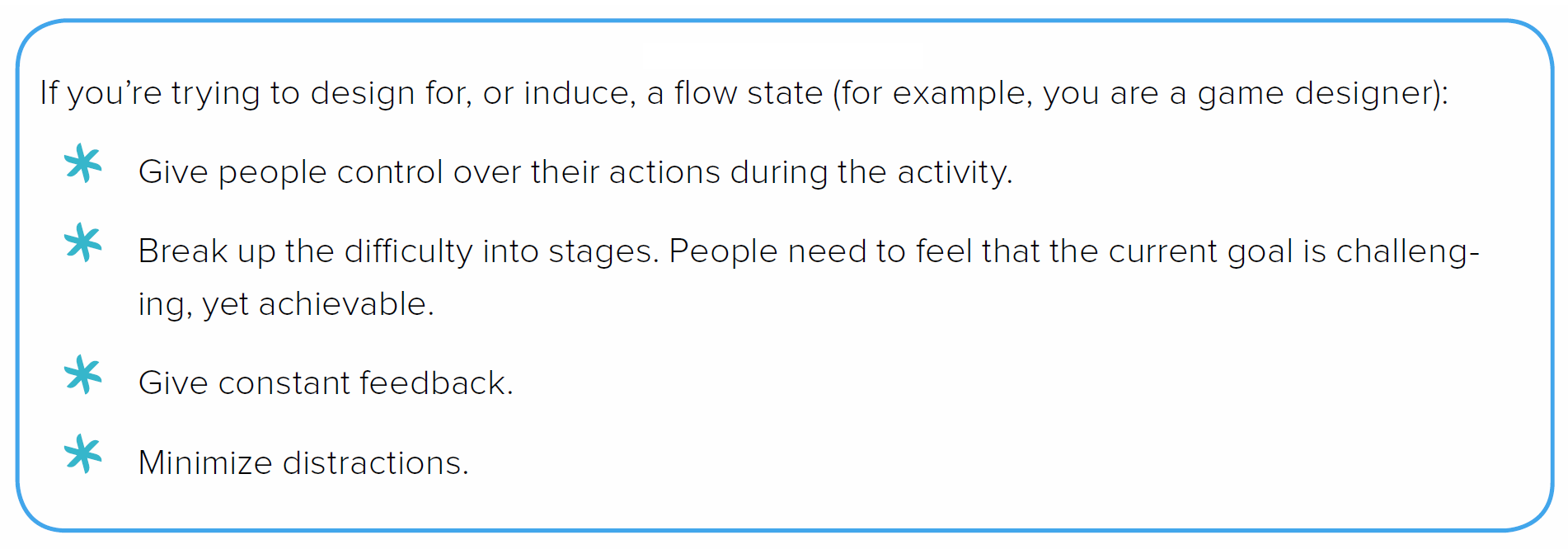Using Flow in Design
Note:
There is extensive use of “Tooltips” text to support learning which do not seem to render on a Smartphone
Therefore this site is best viewed via a computer’s HD monitor
People Can Be In a Flow State
(Weinschenk 2011, p. 91) says:
“Imagine you’re engrossed in some activity. It could be something physical like rock climbing or skiing, something artistic or creative like playing the piano or painting, or just an everyday activity like working on a PowerPoint presentation or teaching a class. Whatever the activity, you become totally engrossed, totally in the moment. Everything else falls away, your sense of time changes, and you almost forget who you are and where you are. What I’m describing is called a flow state”
“The man who wrote the book on flow is Mihaly Csikszentmihalyi. He’s been studying the flow state around the world for many years. Here are some facts about the flow state, the conditions that produce it, what it feels like, and how to apply the concept to your designs:”
(Weinschenk 2011, p. 91):
“You have very focused attention on your task. The ability to control and focus your attention is critical. If you get distracted by anything outside the activity you’re engaging in, the flow state will dissipate. If you want people to be in a flow state while using your product, minimize distractions when they are doing a particular task”
“You’re working with a specific, clear, and achievable goal in mind. Whether you’re singing, fixing a bike, or running a marathon, the flow state comes about when you have a specific goal. You then keep that focused attention and only let in information that fits with the goal. Research shows that you need to feel that you have a good chance of completing the goal to get into, and hold onto, the flow state. If you think you have a good chance of failing at the goal, then the flow state will not be induced. And, conversely, if the activity is not challenging enough, then you won’t hold your attention on it and the flow state will end. Make sure to build in enough challenge to hold attention, but don’t make the tasks so hard that people get discouraged”
“You receive constant feedback. To stay in the flow state, you need a constant stream of information coming in that gives you feedback as to the achievement of the goal. Make sure you are building in lots of feedback messages as people perform the tasks”
“You have control over your actions. Control is an important condition of the flow state. You don’t necessarily have to be in control, or even feel like you’re in control of the entire situation, but you do have to feel that you’re exercising significant control over your own actions in a challenging situation. Give people control at various points along the way”
(Weinschenk 2011, p. 92):
“Time changes. Some people report that time speeds up—they look up and hours have gone by. Others report that time slows down”
“The self does not feel threatened. To enter a flow state, your sense of self and survival cannot feel threatened. You have to be relaxed enough to engage all of your attention on the task at hand. In fact, most people report that they lose their sense of self when they are absorbed with the task”
“The flow state is personal. Everyone has different activities that put them in a flow state. What triggers a flow state for you is different from others”
“The flow state crosses cultures. So far it seems to be a common human experience across all cultures with the exception of people with some mental illnesses. People who have schizophrenia, for example, have a hard time inducing or staying in a flow state, probably because they have a hard time with some of the other items above, such as focused attention, control, or the self not feeling threatened”
“The flow state is pleasurable. People like being in the flow state”
References:
Weinschenk, S., 2011. 100 things every designer needs to know about people. Berkeley, CA: New Riders.
